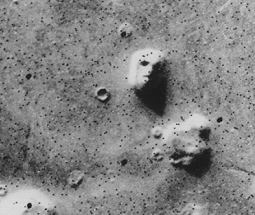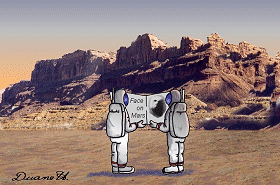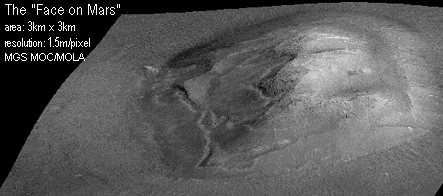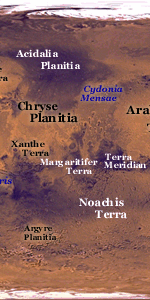|
New high-resolution images and 3D altimetry
from NASA's Mars Global Surveyor spacecraft reveal the Face on Mars
for what it really is: a mesa.
by Dr Tony Phillips
Twenty five years ago something funny
happened around Mars. NASA's Viking 1 spacecraft was circling the
planet, snapping photos of possible landing sites for its sister ship
Viking 2, when it spotted the shadowy likeness of a human face. An
enormous head nearly two miles from end to end seemed to be staring
back at the cameras from a region of the Red Planet called Cydonia.
There must have been a degree of surprise
among mission controllers back at the Jet Propulsion Lab when the
face appeared on their monitors. But the sensation was short lived.
Scientists figured it was just another Martian mesa, common enough
around Cydonia, only this one had unusual shadows that made it look
like an Egyptian Pharaoh.
A few days later NASA unveiled the
image for all to see. The caption noted a "huge rock formation ...
which resembles a human head ... formed by shadows giving the illusion
of eyes, nose and mouth." The authors reasoned it would be a good
way to engage the public and attract attention to Mars.
It certainly did!
The "Face on Mars" has since become
a pop icon. It has starred in a Hollywood film, appeared in books,
magazines, radio talk shows - even haunted grocery store checkout
lines for 25 years! (It has no body though, so at least there is
no need for life
insurance quotes!) Some people think the Face is bona fide
evidence of life on Mars - evidence that NASA would rather hide,
say conspiracy theorists. Meanwhile, defenders of the NASA budget
wish there was an ancient civilisation on Mars.
Although few scientists believed the
Face was an alien artefact, photographing Cydonia became a priority
for NASA when Mars Global Surveyor (MGS) arrived at the Red Planet
in Sept. 1997, eighteen long years after the Viking missions ended.
"We felt this was important to taxpayers," explained Jim Garvin,
chief scientist for NASA's Mars Exploration Program. "We photographed
the Face as soon as we could get a good shot at it."

A 1976
Viking 1 photograph of the Face on Mars. Click
here for a 2001 photo from Mars Global Surveyor that reveals
the true appearance of the Face.
|
And so on April 5, 1998, when Mars
Global Surveyor flew over Cydonia for the first time, Michael Malin
and his Mars Orbiter Camera (MOC) team snapped a picture ten times
sharper than the original Viking photos. Thousands of anxious web
surfers were waiting when the
image first appeared on a JPL web site, revealing ... a natural
landform. There was no alien monument after all.
But not everyone was satisfied. The
Face on Mars is located at 41 degrees north martian latitude where
it was winter in April '98 - a cloudy time of year on the Red Planet.
The camera on board MGS had to peer through wispy clouds to see
the Face. Perhaps, said sceptics, alien markings were hidden by
haze.
Mission controllers
prepared to look again. "It's not easy to target Cydonia," says
Garvin. "In fact, it's hard work." Mars Global Surveyor is a mapping
spacecraft that normally looks straight down and scans the planet
like a fax machine in narrow 2.5 km-wide strips. "We just don't
pass over the Face very often," he noted.
Nevertheless, on April
8, 2001 - a cloudless summer day in Cydonia - Mars Global Surveyor
drew close enough for a second look. "We
had to roll the spacecraft 25 degrees to centre the Face in the
field of view," said Garvin. "Malin's team captured an extraordinary
photo using the camera's absolute maximum resolution." Each pixel
in the 2001 image spans 1.56 meters,
compared to 43 meters per pixel in the
best 1976 Viking photo.

Side by side:
a Viking 1 photo from 1976, a Mars Global Surveyor (MGS) image
from 1998, and the latest MGS image from 2001.
|
"As a rule of thumb, you can discern
things in a digital image 3 times bigger than the pixel size," he
added. "So, if there were objects in this picture like airplanes
on the ground or Egyptian-style pyramids or even small shacks, you
could see what they were!"
What the picture actually shows is
the Martian equivalent of a butte or mesa - landforms common around
the American West. "It reminds me most of Middle Butte in the Snake
River Plain of Idaho," says Garvin. "That's a lava dome that takes
the form of an isolated mesa about the same height as the Face on
Mars."

"Gee, it doesn't
look like a face to me!" by artist Duane Hilton.
|
Cydonia is littered with mesas like
the Face, but the others don't look like human heads and they've
attracted little popular attention. Garvin and other members of
the MGS Science Team have studied them carefully, however, using
a laser altimeter called "MOLA" on board Mars Global Surveyor.
MOLA can measure the heights of things
with a vertical precision of 20 to 30 cm (its horizontal resolution
is 150m). "We took hundreds of altitude measurements of the mesa-like
features around Cydonia," says Garvin, "including the Face. The
height of the Face, its volume and aspect ratio - all of its dimensions,
in fact - are similar to the other mesas. It's not exotic in any
way."
The laser altimetry data are perhaps
even more convincing than overhead photos that the Face is natural.
3D elevation maps reveal the formation from any angle, unaltered
by lights and shadow. There are no eyes, no nose, and no mouth!

A 3D perspective
view of the Face on Mars landform produced by Jim Garvin (NASA)
and Jim Frawley (Herring Bay Geophysics) from the latest MOC
image (April 8, 2001) and all of the available laser altimeter
elevation measurements by MOLA. There is no vertical exaggeration
in this ray-traced image. Garvin and Frawley express special
thanks to Mike Malin and MOLA science team.
|
The mesas of Cydonia are of great interest
to planetary geologists because they lie in a curious part of Mars,
in a transition zone between cratered highlands to the south and
smoother lowland plains to the north. Some scientists think the
northern plains are all that's left of an ancient Martian ocean.
If so, Cydonia might have once been beachfront property.
"Ocean advocates say the mesas are
just what you would expect to see near the edge of the water ...
that is, free-standing eroded landforms," says Garvin. "But there
are many possibilities." The mesas could have been gouged by glaciers,
carved by winds and water, or thrust upward by vertical tectonics.
"We simply don't know."

Cydonia (labelledblue)
inhabits a transition zone between southern highlands and
a northern plain that perhaps once contained a Martian ocean.
Click for the full Mars
Atlas.
|
Perhaps the best way to unravel the mystery would be to send a geologist
to investigate. And Garvin, an enthusiastic climber, wouldn't mind
going himself.
"I can imagine myself staring up at
this 800-foot-high mass of rock with steep flanks," he says, "the
same as Middle Butte in Idaho. An apron of boulders around the base
would make the climb difficult [for a robot], but a human could
do it well." The latest MGS images of the Face are so detailed that
Garvin already knows what route he would take - he's even prepared
a trail map! "The start and midsection of the hike would be easy,
with some steep flanks in between. It would take about two hours
to reach the summit."
"From there the view would be spectacular,"
he continued. "To the south the ground would slope upwards, toward
the highlands. To the north the terrain would descend toward the
plains. Looking around you would see a barren landscape dotted with
buttes, mesas, and impact craters," a curious mix of the bizarre
and the familiar.
"Mars is a special place, it reminds
us of home ... one day we are going to go there," says Garvin.
That's why the Face on Mars was so popular: it reinforced that connection.
But even without an alien monument, there will be plenty for future
explorers to do. Climbing the mesas of Cydonia -if that's where
we start- will be just the beginning.
|
